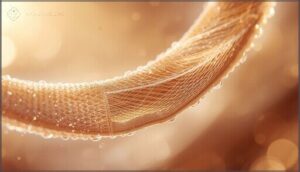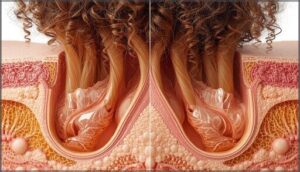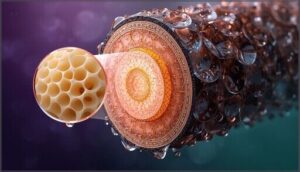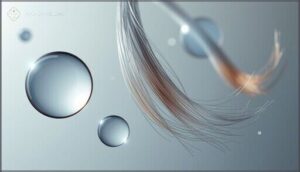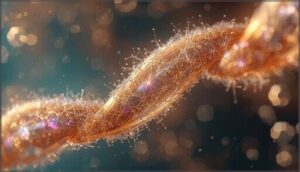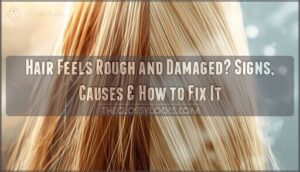This site is supported by our readers. We may earn a commission, at no cost to you, if you purchase through links.

Your hair’s curl pattern isn’t random—it’s determined by a precise molecular architecture encoded in your DNA and expressed through the physical structure of each follicle beneath your scalp. The difference between a tight coil and a straight strand comes down to follicle shape, disulfide bond distribution within keratin proteins, and genetic variants inherited from both parents.
While 85-95% of curl pattern variation traces back to heredity, the story doesn’t end with genetics alone. Environmental factors like humidity disrupt hydrogen bonds and trigger frizz, chemical treatments reshape disulfide bridges, and even UV radiation gradually breaks down the protein matrix that holds your curls in place.
Understanding what causes curly hair means examining the interplay between your biological blueprint and the forces constantly reshaping it.
Table Of Contents
- Key Takeaways
- What Determines Hair Texture and Shape?
- How Genetics Cause Curly Hair
- How Hair Grows Curly or Straight
- Chemical and Biochemical Factors in Curl Formation
- Environmental Impacts on Curly Hair
- Cultural and Scientific Perspectives on Curly Hair
- Frequently Asked Questions (FAQs)
- Why do people have curly hair?
- Why is my hair falling out?
- Why are hair strands Curly?
- Can diet or nutrition change hair texture?
- Why does hair curl differently when wet?
- Does stress affect hair curl pattern permanently?
- Can curly hair become straight with age?
- How do scalp conditions influence curl formation?
- Conclusion
Key Takeaways
- Your curl pattern is locked in by follicle shape (curved vs. straight), disulfide bonds within keratin proteins, and genetic variants inherited from both parents—with 85-95% of texture variation tracing directly back to heredity.
- The difference between coils and straight strands comes down to follicle geometry: oval or elliptical follicles produce curly hair, while round follicles yield straight strands, and this structural blueprint is written into your DNA before a single strand emerges.
- Environmental factors like humidity, UV radiation, and pollution constantly reshape your curls by breaking hydrogen bonds, degrading keratin proteins, and clogging follicles—meaning your texture is both genetically determined and dynamically responsive to external forces.
- Chemical treatments (relaxers, perms, dyes) rewrite your hair’s natural structure by manipulating disulfide bonds, but they come with lasting consequences including weakened cortex, cuticle damage, and even doubled cancer risks for frequent straightener users.
What Determines Hair Texture and Shape?
Your hair’s texture isn’t random—it’s the result of a precise biological blueprint written into every strand. From the molecular bonds holding keratin together to the shape of the follicle beneath your scalp, multiple factors work in concert to determine whether your hair spirals, waves, or falls straight.
Let’s break down the structural elements that give your hair its unique character.
Hair Shaft Structure and Composition
Your hair shaft—the visible part you style and fuss over—holds three distinct layers that determine your curl pattern. The outermost cuticle layers protect inner structures, while the cortex, packed with keratin composition and alpha-keratin proteins, dominates hair texture through its fiber strength and flexibility. Deep inside, the medulla adds thickness variability.
These keratinocytes harden into the hair structure emerging from your hair follicle, creating your unique curl signature. Understanding the hair structure basics is essential for maintaining healthy and strong hair.
Role of Hair Follicle Shape
Your follicle geometry dictates everything. If your hair follicle sits at an angle beneath your scalp—curved or elliptical rather than straight—you’ll see curly hair formation from the moment your hair shaft emergence begins.
This follicle asymmetry creates pronounced curl patterns, with cellular distribution shifting dramatically on the concave side. Think of it as your follicular structure writing your curl destiny, determining your hair morphology before a single strand breaks the surface. That’s hair shape in action.
Understanding the role of genetic variants can provide further insights into curly hair formation.
Medulla, Cortex, and Cuticle Influence
Three distinct layers shape your curl destiny. The medulla provides minor structural support, while the cortex houses keratin arrangement and disulfide bond impact, permanently locking in curl patterns. The outermost cuticle controls moisture retention, determining whether your curls stay defined or spiral into frizz.
These layer interaction effects work together, influencing your hair texture through intricate hair biology that’s uniquely yours.
Cross-Sectional Differences in Hair
Beyond those layers, your cross section geometry tells the real story. Hair fiber analysis reveals striking ellipticity measurements—straight strands show circular symmetry while curly fibers display pronounced ellipse shapes.
Consider the follicle shape impact on hair shaft variations:
- Asian hair: ~4,804 µm² cross-sectional area, circular geometry
- African hair: ~4,274 µm² area, highly elliptical structure
- Caucasian hair: ~3,857 µm², moderate ellipticity
Your hair genetics and genetic variation determine these measurements, explaining why hair texture differs dramatically across populations.
How Genetics Cause Curly Hair
Your curls didn’t just happen by chance—they’re written into your DNA, passed down through generations in a complex genetic blueprint. The way your hair coils, spirals, or waves comes from specific genes you inherited from your biological parents, and these genes work together in surprisingly intricate ways.
Let’s break down how your genetic code shapes every curve and kink in your hair.
Inheritance Patterns From Parents
Your curls aren’t random—they’re written in your genetic code. Curly hair follows dominant inheritance patterns, meaning just one curly allele from either parent generally overrides straight hair genes.
Heritability rates sit between 85-95%, with each parent contributing two alleles that determine your final texture. Family traits can skip generations when recessive alleles hide, explaining why your hair might differ from your parents’ despite clear genetic influence.
Key Genes Linked to Curly Hair
Your hair’s curl pattern lives in your genetic code, shaped by specific genes that control follicle shape and keratin structure. Genetic variants like TCHH, KRT74, and CUTC determine hair texture through gene expression in your follicle cells, with each contributing unique influences on curl formation.
- TCHH stabilizes your inner root sheath, molding each strand’s curvature
- KRT74 controls mechanical forces that determine curl tightness
- CUTC regulates copper levels, affecting keratin cross-linking and strength
Dominant and Recessive Genetic Traits
Your curly hair genetics aren’t a simple coin toss. While curly hair behaves as a dominant gene in Punnett Squares, the reality involves Polygenic Inheritance—multiple genes working together.
Carrier Status matters because you can pass hidden straight-hair alleles to your children, even with curly locks yourself. Allele Interactions create unexpected outcomes, explaining why Population Frequency data shows straight hair dominating globally despite curly’s genetic advantage.
Genetic Diversity and Ancestral Origins
Your Genetic Variation reflects where your ancestors lived—Ancestral Roots shape everything. Population genetics reveals that tightly coiled hair emerged in sub-Saharan Africa, where Hereditary Traits adapted to intense heat.
Gene Expression reacts to Hair Evolution and climate, creating Genetic Origins of Hair that protect against UV radiation.
The Genetic Influence on Hair demonstrates how Hair Texture and diversity mirror migration patterns, with Genetic Factors and ancestry intertwining across continents.
How Hair Grows Curly or Straight
You already know that genetics loads the gun, but it’s the follicle that pulls the trigger. The way your hair grows—whether it spirals into ringlets or falls poker-straight—comes down to what’s happening beneath your scalp, where living cells are constantly dividing and building each strand from the ground up.
Let’s break down the biological mechanics that turn those genetic instructions into the hair you see in the mirror.
Follicle Structure and Hair Growth
Your follicle isn’t just a factory—it’s a living architect sculpting every strand from the inside out. Hair follicles determine hair shape through three fundamental mechanisms:
- Asymmetrical inner root sheath distribution creates uneven cellular pressure during growth dynamics
- Curved follicle bulb morphology physically bends the emerging hair shaft
- Variable keratinocyte migration patterns influence fiber curvature throughout the hair growth cycle
Understanding follicle asymmetry unlocks the mystery behind your unique texture.
Impact of Cell Division and Keratinocytes
Think of your follicle as a microscopic workshop where cellular choreography determines your curl pattern. Keratinocyte proliferation drives hair growth through strategic cell division orientation—cells dividing perpendicular to the basement membrane create differentiated inner layers that shape your texture. Apoptosis influence and keratinocyte differentiation regulate hair follicle regeneration cycles, while regional hair properties emerge from compartmentalized stem cell activity.
| Cellular Process | Impact on Curl Formation |
|---|---|
| Junctional zone division | 3–5 divisions per cycle, nearly double bulge activity |
| Perpendicular cell division | Produces differentiated cells that shape hair fiber |
| Symmetric bulge division | Expands outer root sheath during anagen phase |
| Apoptosis activation | Initiates telogen-anagen shift, stimulating new growth |
| Keratin gene expression | Altered KRT31/34 affects follicle formation and curl induction |
Your hair biology and chemistry unfold through these precisely orchestrated cellular events, transforming stem cells into the curls you see.
Influence of Hormones on Follicle Shape
Your hormones pull the strings behind follicle architecture, shaping every curl you’ve got. Androgen effects like DHT bind to receptors in dermal papilla cells, remodeling follicle structure and hair shape.
Estrogen influence maintains helical follicles critical for curly hair, while progesterone role inhibits androgen conversion.
Thyroid impact and stress hormones alter follicle dynamics, directly affecting your hair biology and chemistry—when hormone levels shift, your curl pattern follows.
Changes in Hair Texture Over Time
Your texture shifts as you age—hair diameter thins after 25, while curvature actually increases, making formerly straight strands frizzier. Hair growth cycles shorten, lengthening the gap between shedding and regrowth, reducing overall hair mass.
Environmental pollution accelerates hair weathering, thinning fibers faster.
Medications, hormonal swings during menopause, and decreased scalp oil production all trigger follicle changes, transforming your curl pattern in ways your genetic factors never predicted.
Chemical and Biochemical Factors in Curl Formation
Your hair’s curl doesn’t just come from the shape of your follicle—it’s locked in place by powerful chemical bonds that determine whether your strands spiral, wave, or fall straight. These bonds can be permanent or temporary, and they’re the reason chemical treatments can transform your texture while a little humidity sends your carefully styled hair into rebellion.
Let’s break down the biochemical architecture that gives curly hair its signature shape and resilience.
Disulfide Bonds and Keratin Structure
Your curly hair’s signature spiral doesn’t just happen by chance—it’s locked in place by powerful disulfide bonds within keratin proteins. These chemical bridges form between cysteine residues in your hair shaft, creating rigid cross-links that withstand tension and maintain curl patterns.
Curly hair actually contains a higher density of these bonds, distributed irregularly throughout the keratin structure, giving your spirals their distinctive flexibility and permanent shape.
Hydrogen Bonds and Temporary Curling
While disulfide bonds lock your curl pattern permanently, hydrogen bonds operate differently—they’re the temporary allies in your hair’s shape-shifting story.
These weak intermolecular forces between keratin coils break when you wet your hair, then reform as it dries, accounting for about 50% of your hair’s elasticity.
That’s why heat-styled curls vanish after a shower—hydrogen bonding makes temporary styling possible but fleeting.
Effects of Chemical Treatments
When you chemically alter your hair’s structure—whether through relaxers, perms, or coloring—you’re fundamentally rewriting your follicle’s natural script, often with lasting consequences. These treatments manipulate or break disulfide bonds to reshape hair texture and shape, but they come at a cost:
- Hair damage and breakage from weakened cortex and cuticle lifting
- Scalp irritation, burns, and chronic dryness from chemical exposure
- Cancer risks—frequent straightener users face doubled uterine cancer rates
Your hair follicle remembers every chemical intervention, and treatment alternatives deserve serious consideration.
Biochemical Reactions Affecting Hair Shape
Beyond the visible changes from salon chemicals, your hair’s shape hinges on internal biochemical reactions that either lock in or loosen curl patterns. Disulfide bonds and hydrogen dynamics within the keratin structure create permanent or temporary curl configurations.
Emerging research on fatty acids and hydrogel coating suggests that follicle biochemistry—not just genetics—can influence hair texture and shape, hair growth and development, and overall hair biology and physiology.
Environmental Impacts on Curly Hair
Your curls don’t exist in a vacuum—they’re constantly reacting to the world around them. Everything from the moisture in the air to the sun beating down on your head can reshape, damage, or even improve your natural curl pattern.
Let’s break down the environmental factors that interact with your hair’s structure and what you can do to protect those spirals.
Humidity and Water Absorption
Your hair follicle’s shape isn’t the only factor driving curl behavior—atmospheric moisture plays a rebellious role too. High humidity opens your cuticles, allowing water absorption that disrupts hydrogen bonds and triggers frizz.
Porosity effects determine whether your curly hair repels or absorbs excessive moisture, directly impacting curl definition.
Well-hydrated strands with sealed cuticles resist humidity impacts better, maintaining hair structure and texture while improving frizz reduction through proper cuticle moisture balance.
UV Radiation and Hair Protein Damage
Sun exposure isn’t just about lightening your curls—UV radiation attacks keratin proteins at the molecular level, breaking down disulfide bonds and triggering progressive protein loss. Your curly hair’s raised cuticles and porosity make it especially vulnerable to radiation effects.
- UVB radiation causes 2–5 times more protein loss than UVA
- Keratin degradation weakens hair structure and increases brittleness
- Melanin breakdown accelerates color fading in exposed curls
- Surface damage intensifies in irregular curl patterns
Effects of Environmental Pollution
Urban air pollution isn’t some distant threat—it’s actively reshaping your curls. Particulate matter clogs follicles, reduces essential growth proteins like beta-catenin, and triggers oxidative stress that breaks down keratin structure.
Chemical exposure from heavy metals disrupts your scalp’s pH balance, while poor water quality leaves mineral deposits that strip curl elasticity.
Environmental influences directly alter hair shape, texture, and follicle health.
Protective Measures for Curly Hair
You can fight back against environmental damage with targeted hair care and maintenance strategies. Protective styling reduces mechanical stress, while heat management prevents protein breakdown that weakens curl preservation. Hair oils seal moisture retention into porous strands, and UV-blocking products shield against radiation damage.
- Deep condition weekly to restore elasticity
- Apply heat protectants before any hair styling and products
- Wear protective styles during high pollution exposure
- Use chelating treatments for mineral-laden water
These hair treatments create a defensive barrier against urban aggressors threatening your follicle health and curl integrity.
Cultural and Scientific Perspectives on Curly Hair
Your hair doesn’t just grow in a vacuum—it carries the weight of ancestry, climate adaptation, and cultural identity. Scientists continue piecing together why certain populations developed distinct curl patterns, while communities around the world reclaim and celebrate their natural textures.
Let’s explore how evolution, ethnicity, culture, and advanced research all intersect to tell the full story of curly hair.
Ethnic and Racial Differences in Curl Patterns
Your genetic blueprint doesn’t play favorites, but it does show up differently depending on your ancestry. These differences trace back to genetic variance in keratin-associated protein genes, which cluster uniquely across populations. Your follicle shape directly influences your curl pattern, creating the beautiful ethnic diversity we see worldwide.
| Ethnic Group | Follicle Shape | Typical Curl Pattern | Cross-Section | Curly Hair Prevalence |
|---|---|---|---|---|
| African Descent | Oval/Flattened | Tightly Coiled/Kinky | Elliptical | ~92% |
| East Asian | Round | Straight | Circular | ~4% |
| Caucasian | Round to Oval | Straight to Curly | Variable | ~12% |
| Hispanic | Variable | Wavy to Curly | Variable | ~13.9% |
| Global Average | Mixed | Diverse Range | Mixed | ~11% |
People of African descent usually sport oval or flattened follicles, creating tightly coiled patterns, while Asian populations lean toward round follicles, producing straight hair. Caucasian hair falls somewhere in between, offering a wider spectrum of textures.
Evolutionary Theories of Curly Hair
Looking beyond modern diversity, curly hair tells a survival story written in your follicles. Climate adaptation drove natural selection, favoring tightly coiled strands in equatorial Africa where they shielded scalps, reducing surface temperatures by 5°C.
This thermoregulation advantage supported brain evolution in early hominins, allowing larger cranial capacity while conserving water. Your curls aren’t just beautiful—they’re evolutionary genius shaped by geographic distribution and genetic origins.
Curly hair is evolutionary genius—it once enabled larger brains by cooling the scalp and conserving water in equatorial heat
Cultural Significance and Representation
Your curls carry centuries of cultural identity, from ancient symbols of divinity to modern movements reclaiming natural beauty. Yet hair discrimination persists—66% of Black children in majority-white schools face bias, and Black women experience 1.5 times more workplace prejudice.
Media representation is shifting through community empowerment and social impact, challenging Eurocentric norms. Your texture isn’t just genetics—it’s heritage, resistance, and the cultural significance of hair itself.
Ongoing Research and Future Discoveries
Beyond cultural pride lies a scientific revolution. Researchers are mapping over 10 genes tied to your curl pattern, while stem cell therapy promises hair regeneration breakthroughs. Curl pattern analysis now uses AI to decode your follicle’s unique architecture.
Future therapies you’ll see:
- Biotech innovations targeting keratin protein expression
- Individualized treatments based on genetic mapping
- Follicle stem cell restoration for pattern enhancement
- Biomimetic formulas strengthening disulfide bonds
- Hair biology insights revolutionizing trichology care
Your curls aren’t mysteries anymore—they’re blueprints for tomorrow’s breakthroughs.
Frequently Asked Questions (FAQs)
Why do people have curly hair?
Your follicles tell the story. When they grow asymmetrically and curve beneath your scalp, keratin proteins stack unevenly, creating curls shaped by genetic blueprints passed down through generations.
Why is my hair falling out?
Around 80 million Americans experience hereditary hair loss. Your hair follicle health depends on genetics, hormonal imbalance, nutrient deficiency, stress factors, and scalp health—all disrupting your hair growth cycle and triggering shedding.
Why are hair strands Curly?
Your hair strands curl because of your follicle shape, keratin structure, and genetics. Elliptical follicles produce curly hair, while disulfide bonds create permanent curl patterns that define your unique hair texture and growth.
Can diet or nutrition change hair texture?
Newsflash: no superfood will magically transform your poker-straight hair into spirals. Nutrient deficiencies, however, compromise hair health, triggering breakage and thinning.
Dietary patterns support hair growth and follicle function, but won’t fundamentally alter your genetically determined texture.
Why does hair curl differently when wet?
When your hair gets wet, water breaks hydrogen bonds between keratin proteins, causing strands to reshape temporarily.
Moisture also triggers hair swelling through water absorption, altering curl patterns until your hair dries completely.
Does stress affect hair curl pattern permanently?
Think of your curls like a garden weathering a storm—they bend, but rarely break permanently. Stress hormone impact disrupts your hair growth cycle temporarily, yet follicle recovery potential remains strong.
Texture change duration varies, though cellular stress response and genetic predisposition role determine whether your hair texture fully rebounds after the storm passes.
Can curly hair become straight with age?
Yes, your curls can loosen or straighten with age. Hormonal shifts, declining sebum production, and changes in hair follicle shape alter curl patterns, while genetic factors and environmental damage accelerate these hair texture transformations.
How do scalp conditions influence curl formation?
Like a telegram from the 1850s—scalp inflammation, sebum regulation, microbiome balance, follicle buildup, and external stressors directly alter your hair follicle’s shape, disrupting hair growth and morphology while compromising scalp health and curl formation.
Conclusion
Your genes write the blueprint, your follicles execute the architecture, and your environment constantly rewrites the final draft—that’s what causes curly hair in its simplest truth.
Every coil emerges from molecular precision you inherited, shaped by forces both internal and external, permanent and fleeting.
Understanding this convergence doesn’t just satisfy curiosity; it allows you to work with your hair’s natural chemistry rather than against it, turning biological inheritance into informed choice.
- https://www.healthline.com/health/is-curly-hair-dominant-or-recessive
- https://www.reddit.com/r/NoStupidQuestions/comments/k6byxd/curly_hair_is_dominate_but_most_people_have/
- https://www.keratin.com/hair-shaft-issues/the-biology-of-curly-hair/
- https://www.poweryourcurls.com/curly-hair-prevalence-by-country-map-types/
- https://www.zurkoresearch.com/noticias/impact-of-environmental-exposure/

